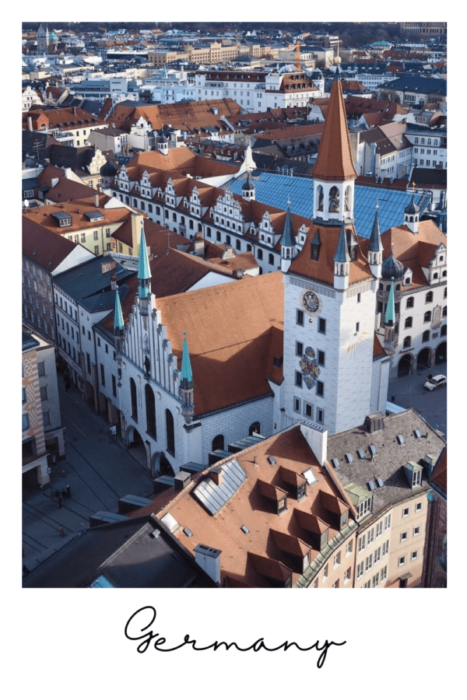The 7 best day trips from Munich by train for 2024
Are you searching for the perfect day trips from Munich by train?
Looking for an easy getaway on Germany’s excellent public transportation from the Bavarian capital out to the most beautiful parts of Bavaria and beyond?
I’ve included 8 unique destinations for you, from medieval masterpieces like Nuremberg and Bamberg to stunning Salzburg nestled between snowy mountains and topped by a fortress.
Or maybe you’re looking for a majestic alpine lake to explore some of nature’s beauty, there’s one of those here too for you to add to your list of perfect day trips!
I’ve included something for everyone in this list of the best day trips from Munich, including the fairy-tale castle of Mad King Ludwig up in the Bavarian Alps.
Grab your camera and come along with me as we discover the best bits of Bavaria by train!
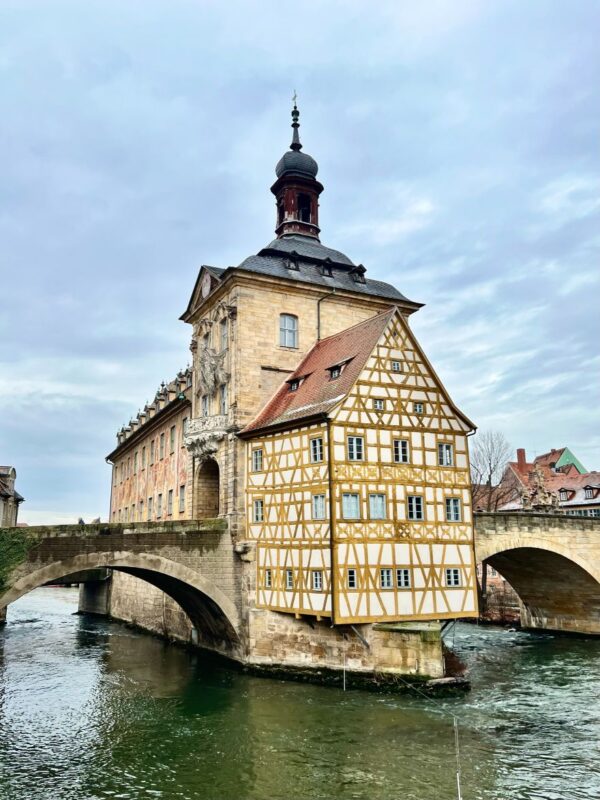

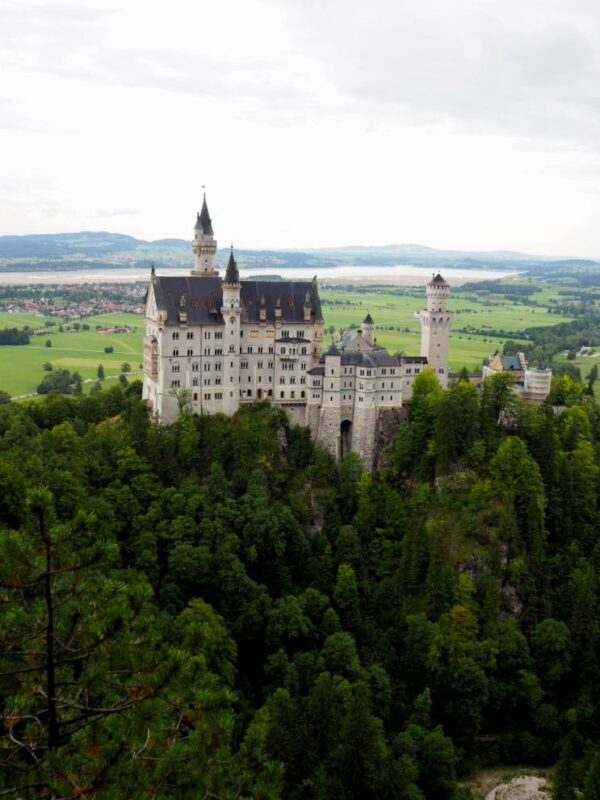
How to use the trains in Bavaria and Germany
The German train system is very well organised and amusingly, considered not punctual by the locals. You might hear some jokes about how the only reliable thing about German trains is that they will never be on time!
But in reality, often the delays are only for a few minutes.
Munich Hauptbahnhof, aka Munich’s main train station, has oodles of train connections to much of Bavaria so it’s a great starting point for these top day trips.
The trains are very well documented over on the official website of Deutsche Bahn, some trips will even display the platform that the train will arrive on weeks in advance.
So, it’s a dream website for an over-planner like me.
If you’d like to book your return journey ahead of time, you can buy tickets on the website for a cheaper price but you will be locked into a certain time and date.
If you’re travelling in a group or you’d like the flexibility of jumping on whichever train suits, the regional ticket (Bayern Ticket) might work out a similar price and you can simply buy it on the day. Read on for more info about the special regional ticket.
Once you have your valid ticket, double check the large screens displayed at the station to confirm what platform number your train will leave from and head over with time to spare.
The platforms can be long and you wouldn’t want to miss your train because you didn’t walk quick enough!
Trains run frequently on most routes though, so if you do happen to miss a train, odds are that it will only be a half hour wait or so until the next one comes along.
Wondering how to spend 24 hours in Munich: I’ve written the best guide for you!
Budget tip 1: Book tickets ahead of time
Confusingly, train tickets come in a few different price categories depending on the region and type of train that you’re planning to catch.
The regional trains (RB, B) are slower and stop at all stations, they also cost less to use and have fixed pricing depending on the distance that you are travelling on the train.
The IC or ICE trains are express lines, stopping only at major cities and coming at a bit of a premium since they take less time to get you to your destination.
The pricing for these trains works a bit like airfares, the earlier you can book your ticket, the cheaper it will be.
Booking the day before is likely to come up with some eye watering prices for tickets, especially on the popular routes.
Top Tip: IC and ICE tickets do not come with a seat reservation included, if you’re travelling for a long period, I’d strongly consider paying the extra Euro or two to ensure that you won’t be standing in the corridor for the duration of the journey.
If it’s the weekend, I would absolutely book a seat reservation but on the weekdays you may be lucky if it isn’t the holidays.
On the regional trains, don’t worry about a seat reservation, they’re not really sold for these routes and you should be okay to get a seat. And they run far more regularly than the IC/ICE trains so they’re not as full.
The DB app also has a handy tool which estimates how busy the trains will be ahead of time to help you decide as well.
Budget Travel Tip 2: Take advantage of regional tickets
Each region of Germany has its own special ticket that allows unlimited travel on local transport (busses, trains and sometimes trams) outside of the city centres. In the case of Bavaria, this would be the BayernTicket.
It covers all of Bavaria and even all the way to Salzburg in Austria, which is very handy indeed for this guide!
This can be purchased for one to five people to use and it allows you to jump on any trains that are regional transport within a certain timeframe.
But there a few little catches to be aware of:
– On weekdays, it only begins at 9 in the morning so be careful that you aren’t accidentally breaking the rules by travelling before your ticket is valid. It lasts until 3am the following morning
– On weekends, it’s valid from midnight on the day of use to 3am the following morning.
– You MUST write everyone’s name onto the ticket once you purchase it in order it to be valid for those passengers. A quaint rule but one that the ticket inspectors may check carefully, so be sure to bring along a pen if you’re planning on using this variety of ticket and write in the full names of those using it – if you’ve purchased it from a ticket machine.
– Technically, you should also have the passports of everyone who will be using the ticket too for the conductor to double check. Personally, I’ve never had a conductor ask to prove that the names are correct but those are the official conditions.
You can also buy the Bayern Ticket for a date ahead of time, the ticket machine will prompt you to select either today or a following day, you can easily select the language that you need when using these fire-engine red machines too. Look for a sign saying “Karten/Tickets” when you’re roaming around the train stations.
Budget Travel Tip 3: Buy the Bayern Ticket for group savings
As I mentioned above, you can purchase the Bayern Ticket for a group of people and save some cash in the process.
The price for one person for a 24hr ticket is 29€, while the price for a two person Bayern Ticket is 39€, saving you 9.5€ per person.
The savings increase as your group gets bigger and you can take 3 children under 15 for free as well.
Keep in mind when you’re using these tickets that they are only for use on regional trains and busses, not the IC and ICE trains.
And they do not qualify for a seat reservation so you might need to stand if the trains are especially busy.
Day Trip No 1: Nuremberg
How often do the trains run: roughly every half an hour
How long does it take to get there: 1hr –1hr 10min
Ticket cost per adult: €29.80 return ticket purchased in advance, Bayern Ticket also valid
This medieval stunner used to be a favourite haunt of the Holy Roman Emperors and all that high brow attention shows here in the beautiful half-timbered houses, impressive city walls and an imposing Imperial Castle high on the hill.
It’s also the second largest city in Bavaria, so there’s plenty to see here!
Charming cobblestoned streets wind their way through the old town, bursting with lovely shops selling homemade spiced gingerbread and vintage treasures.
Plus, plenty of atmospheric taverns serving up cellar brewed Rotbier and crispy roast pork or finger sized Nurnberger Bratwurst to delight you.
You could stop by the Goldenes Posthorn, in operation since 1498 and formerly the local pub for the famous medieval painter Albrecht Durer.
Don’t miss the incredibly charming Hangman’s Bridge (Henkersteg) surrounded by weeping willows in the middle of a river.
A one-time home for the hangman of Nuremberg and his family, back when they were considered unsavoury and therefore not permitted to live inside the broad city walls.
These days though, the tiny little dwelling and tower are as pretty as a picture.
Another popular stop is the Heilig Geist Spital, originally built as a hospital for the poor of the city, it still functions as an aged care home to this day.
If you’re here in December, don’t miss the world-famous Christkindlesmarkt where candy cane striped stalls sell fresh gingerbread and mulled wine galore in the main square.
Surrounded by delightful townhouses and the many spired Frauenkirche, there are twinkly lights and boughs of holly wherever you look, completing the picture-perfect Christmas scene.
Pick up some lacey, hand-made stars to hang from your Christmas tree back home or maybe a cannister of delicate Elisenlebkuchen to eat on the train home is more your style.
The large, flat gingerbread cookies are made to a centuries old recipe and are mostly made of spices and nuts with a tiny amount of flour to hold everything together.
And the tins come in all kinds of beautiful designs and colours, perfect for special keepsakes when you’re back from your incredible day trip to Nuremberg.
Don’t miss the perfectly named “Schöner Brunnen” or beautiful fountain on the far side of the Marktplatz, this is a rebuilt replica of a Gothic fountain.
Look closely and you’ll find two rings meshed into the iron grill surrounding the fountain, legend says that spinning the gold one three times will grant your wishes!
Need the inside scoop on what to see? I’ve got the best walking tour of Nuremberg over here!
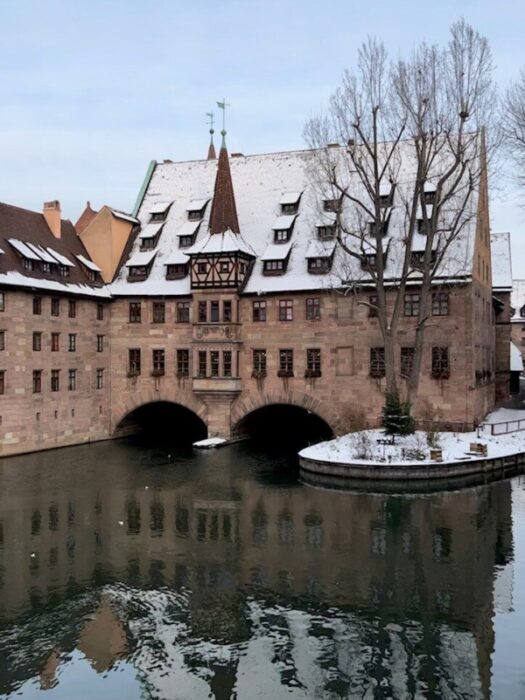
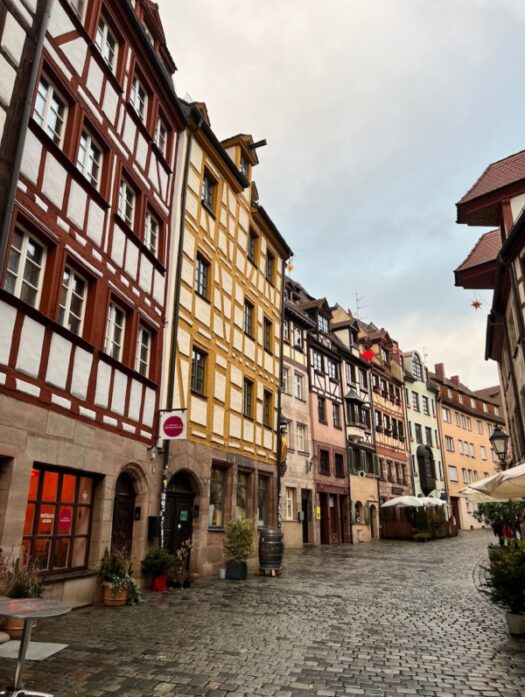

Day Trip No 2: Neuschwanstein
How often do the trains run: 3 times a day, change trains once, change from train to a bus for final leg
How long does it take to get there: 2 hours, 30 minutes allowing for transport changes
Ticket cost per adult: €52 return – I’d strongly recommend the Bayern Ticket instead of single tickets
I’m sure you’ve seen plenty of screensavers of arguably one of the world’s most famous castles, Neuschwanstein, perched high in the foothills of the Bavarian Alps.
This is your chance to visit in person!
Built by “mad” King Ludwig II, he loved dramatic castles from fairytales and storybooks and set about building his own, rather expensive ones once he was king.
He was also a big fan of the elaborate operas put together by Richard Wagner and his dramatic castle up in the hills is full of dramatic details.
It was actually designed to be bigger, but building it almost bankrupted the proud kingdom of Bavaria and the outraged ministers put the brakes on the rest of Ludwig’s fanciful projects.
He was declared insane, deposed by his government and was found floating dead in Starnberger See at the age of 40, though debate still continues about whether his death was accidental, self-inflicted or something more sinister.
He really did get the last laugh though because in the present day, Neuschwanstein is the most visited tourist attraction in all of Bavaria and provides the most tourism income for the state.
Not so much of a silly fantasy anymore!
Now that we’ve covered off a brief history of the castle, how do we get there from Munich?
It is a little bit trickier to reach by train than some of the other destinations in this article, as the nearest village is only small.
If you’re looking for the simplest way to get to Neuschwanstein without needing to worry about changing transport methods, there are multiple guided tours which will get you there with the least amount of hassle.
Or if you’re planning to hire a car, there’s plenty of (paid) car parking a short walk from the castle.
Double check the Deutsche Bahn website for the exact details on the day that you’re planning to travel on, this will be kept up to date and also show any disruptions before you head out of the city via train.
The castle was built between 1869 and 1886 and sits high enough in the foothills of the Bavarian Alps that it’s dusted with snow for much of the winter.
You’ll spot the yellow Schloss Hohenschwangau on your way up, overlooking the stunning alpine lake of Alpsee.
Walking around and admiring the incredible architecture of the castle and its turrets perched on the rock is free.
If you’d like to see inside the lavish castle itself, you can book ahead online but be sure to leave some leeway to be able to make your timeslot.
There’s no squeezing latecomers in and it does get very busy in summer with tour groups.
You can buy tickets online in advance for 20.50€ per adult, they do sell out a long way in advance so be sure to book in as soon as you know your visit dates.
After you’ve admired the fairytale turrets and courtyards up close, don’t miss the incredible beauty of the castle in its picturesque surroundings.
Be sure to head out to the Marienbrücke for that perfect view out over the dramatic towers of the castle to the sweeping valleys and lakes beyond, there are a few other footpaths to different viewpoints depending on your fitness level.
Keep in mind that in winter, they do close the Marienbrücke in bad weather for safety. Those wooden planks can be slippery in wet or icy weather so be careful up there!
Note: If you decide you would like to enjoy the guided tour once you’re at the castle, stop by the ticket office down the bottom of the hill to check if there are any last minute tickets available for the day.
While the interiors are impressively luxurious, photography and filming are strictly prohibited inside the castle itself. Drones are also forbidden when visiting so you can save yourself some backpack room
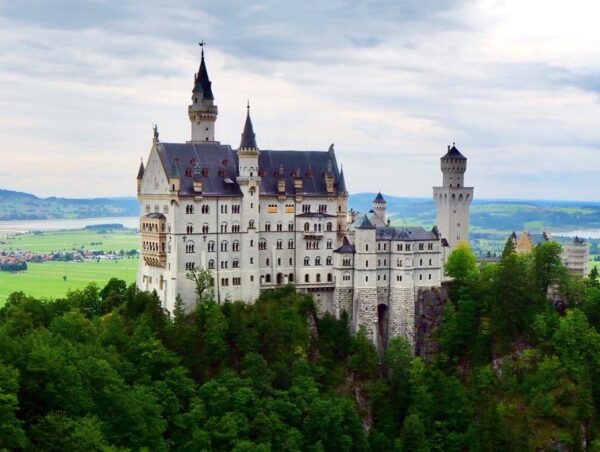

Day Trip No. 3: Regensburg
How often do the trains run: roughly every 30-40 minutes
How long does it take to get there: 1hr 30min
Ticket cost per adult: Return journey booked in advance 29.00€, Bayern Ticket also valid
If you’re looking for a charming medieval city in Bavaria, topped off with a 900 year old bridge, Regensburg has everything you need.
The UNESCO listed Old Town has some of the best preserved medieval architecture in Germany, nestled around the Danube River, the source of Regensburg’s wealth as a trading port. These days, the winding streets, delightful pastel townhouses and Gothic architecture draw visitors from all over.
The Stone Bridge, actually the oldest bridge in Germany, provided an essential crossing point over the Danube for over 9 centuries. It originally came topped with three towers but only one remains, the delightful rose pink one closest to the cathedral.
Stop off at the Stadtamhof Island, this little patch out in the middle of the Danube used to be its own separate village way back in the Middle Ages.
Now absorbed by the city, the best things to see include hidden little laneways and multi-coloured houses, just waiting to delight you.
You might even find time to swing by the adorable Kuchenbar for a streetside slice of cake with a view back over the cathedral.
The towering twin spires of St Peter’s are visible from just about everywhere in the Old Town, a visit inside is well worth it to see the enormous stained glass windows dominating the interior.
If you’d prefer a savoury food stop, the historic Wurstkuchel has stood just next to the Stone Bridge for centuries feeding the hungry folk of Regensburg.
Its roots stretch all the way back to 1146 and the tiny restaurant usually serves up over 6000 sausages a day, along with fresh Brezen and steins of beer.
Your trip to Regensburg wouldn’t be complete without making your way out to Walhalla.
This monument, reminiscent of a Roman temple, stands out on the banks of the Danube with its many columns and elaborate facade.
Built by King Ludwig I to commemorate different Bavarian heroes and VIPs, the temple is an interesting sight to behold in the middle of Bavarian countryside.
It’s easily reached via boat or bus tour from the city center.
For a quirkier visit amidst all of those dramatic medieval buildings, head over the Dackelmuseum.
This oddball museum is devoted to all things Dachshund, much adored for their long bodies and stout little legs.
You’ll find more statues and long dog related memorabilia than you would have thought possible in this shrine to the beloved sausage dogs.
Fans of the breed will absolutely be in seventh heaven here.
Day Trip No. 4: Salzburg
How often do the trains run: every 15-30 minutes
How long does it take to get there: 1hr 30min
Ticket cost per adult: Return journey booked in advance €17.90, Bayern Ticket will also allow you to visit Salzburg.
If you’d like to visit the picturesque setting of the Sound of Music, nestled into snowy hills and watched over by the imposing Hohensalzung Fortress, the beautiful city of Salzburg is waiting for you.
Plus, it’s easily reachable via direct train from Munich and is even covered by the Bayern Ticket, even though it’s over the border in Austria
The regal city center is packed with classic Baroque architecture and multiple cathedrals, the colossal Dom zu Salzburg has to be seen to be believed.
For fans of classical music, Mozart’s childhood house lies over on Makartplatz and you can even try a chocolate ball confection (known as a Mozartkugel) at Cafe Konditorei Fürst in the Old Town. It’s made for fans of nuts though, as it comes with almond paste or marzipan inside and they are quite a rich treat.
You may find a line to this classic shop but it moves relatively quickly as there isn’t a huge selection inside.
Don’t miss strolling along the popular Getriedegasse, lined with charming old shops complete with their original wrought iron signs and plenty of luxury goods.
You might also pass the Café Tomaselli coffee shop, said to be the oldest in the city, though the prices inside certainly reflect its popularity. I’d suggest 220GRAD over in Nonntal instead.
On your way up to the Hohensalzburg Fortress, stop by the Restaurant Stiegl-Keller terrace for a spot of traditional Austrian cuisine and house brewed beer.
You can either enjoy your meal inside in the historic dining room, complete with antler sets adorning the walls or out on the terrace in warmer weather.
If you’re visiting in winter, the terrace will likely be packed up but you’ll still be able to wander out and enjoy the views over the cathedral and the city.
The Hohensalzburg Fortress has stood in some form or another looking out over the rooftops of Salzburg for nearly 10 centuries and has never been conquered.
Built with the riches flowing from the Austrian salt mines, it enjoys impressive views out over the snowy mountains nearby and the shining river flowing through the Old Town.
There’s also an interesting exhibition on the history of the fortress and the city itself.
Tickets can be easily purchased online on the official website, you can also purchase a trip up on the funicular going up the hill. Or if you’ve got energy to burn, you can walk up the road yourself to the fortress, a short and sharp hike for you.
There are also steps up if you’d prefer to take an even steeper way up.
You’ll find the best views of it from across the river, from the Kapuziner Monastery.
Which has a much shorter set of steps on the way up and an incredible vista over the elevated fortress, colourful city houses and snow dusted mountains behind.
Don’t miss the charming Mirabell Palace, surrounded by beautiful flowers and manicured gardens over this side of the river, bonus points if you can name the Sound of Music scene that was once filmed here.
The gardens are lovely to walk around, stop into a cafe to grab a takeaway coffee and sit down on a handy bench here to enjoy the serenity.
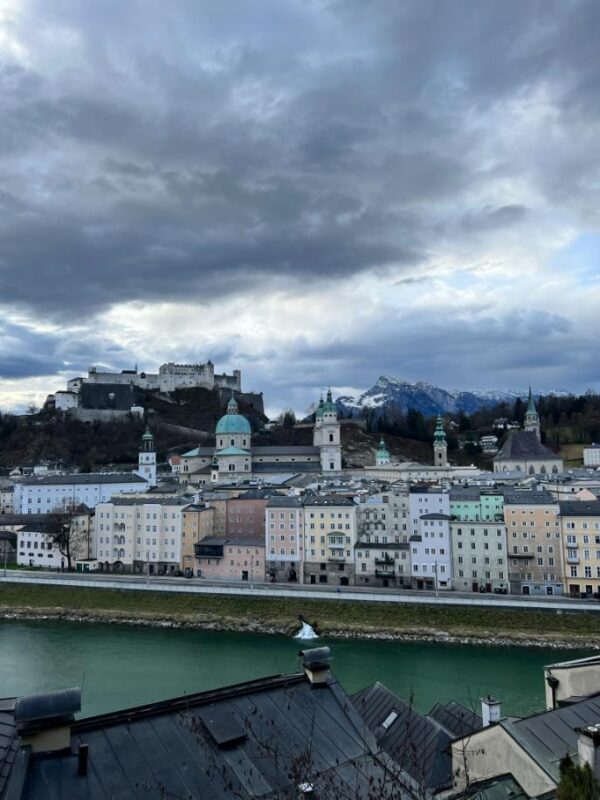
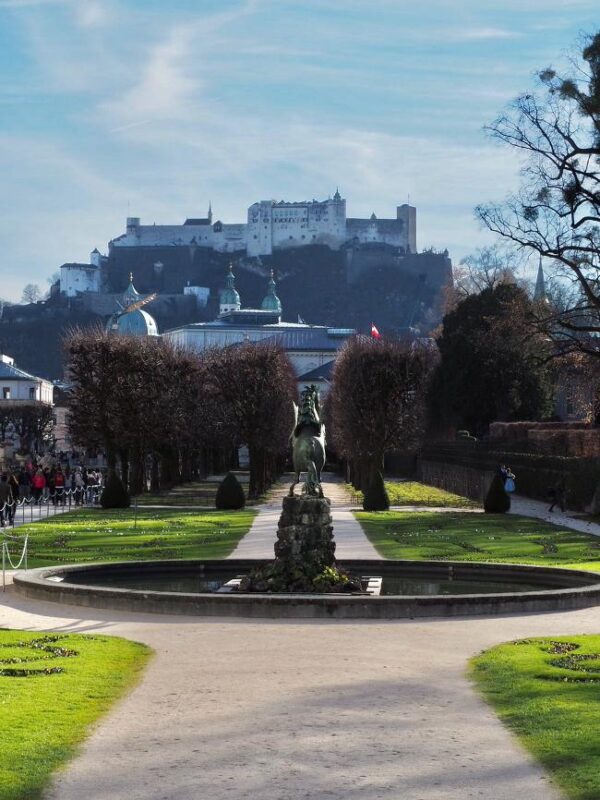

Day Trip No. 5: Bamberg
How often do the trains run: roughly every 30 minutes depending on connection
How long does it take to get there: 1hr 45min
Ticket cost per adult: Return ticket booked in advance €17.90, Bayern Ticket also valid
The stunning little medieval town of Bamberg is full of the cutest fisherman’s houses, a jumbo cathedral and even a town hall out in the middle of the river – the perfect postcard scene.
Formerly a home to royalty, it’s more of a sleepy village now compared to what it must have looked like in the Middle Ages. Luckily for us, all of those historic buildings are beautifully preserved and make for the perfect picture backdrops.
The entire Old Town is actually a Unesco World Heritage Site thanks to its authenticity. A must visit for keen photographers, you’re sure to find a darling cottage just crying out to have its photo taken.
Wander your way to the compact old town, you might have the lovely farmer’s market in full swing – you’ll be able to smell the roasting nuts before you see them.
Soon you’ll be entranced by the Gothic stunner that is the Old Town Hall or Altes Rathaus, perched on a little island out in the middle of the Regnitz river.
Beloved by the locals, both sides are fancifully decorated with colourful murals and OTT sculptures above the gateway. There’s even a cherub’s leg sticking out of one of the walls, though it may take you a bit to spot!
You’ll also be surrounded by charming fisherman’s cottages with their half-timbered facades and colourful paintwork, this quaint area is named Klein Venedig or Little Venice. Intersected by canals and criss-crossed with bridges, the river is a way of life for some of the oldest families in Bamberg.
Wander down to the Untere Brücke to admire the benevolent statue of Queen Cunigunde, an instrumental figure in Bamberg’s long history, against the backdrop of the blue and white Heller Haus. As well as charming views over the flower-filled gardens of Klein Venedig if you’re visiting during the warmer months!
Crossing onto the Geyerswörthsteg bridge will bring you to not only the famous view back over the Altes Rathaus but also the Brudermühle water mill, formerly used to crush grain.
Stroll into the rest of the Old Town, perhaps you’re hungry for hearty Franconian fare like a stuffed onion or crispy roast pork over at Schlenkerla.
Dating back to the 15th century, this family run affair still brews Rauchbier or smoke beer in house, one of only two breweries in Bamberg still producing the historic beverage.
For a real taste of Bamberg, your day trip won’t be complete without sampling a few local culinary specialities.
And the pub is wedged into some of the most delightful streets lined both sides with half timbered townhouses in all shades of pastel.
After your tasty lunch, head up the hill to the imposing Bamberger Dom or Bamberg Cathedral. Built to impressively large specifications, this Gothic masterpiece enjoys a commanding position high above the city.
Inside, you’ll find the mythical Bamberg Knight statue. The lifesize figure is world famous and yet historians still debate who the rider is meant to represent, gazing out in stone for all of eternity.
Next door, you’ll find the Alter Hof, historic home to emperors and kings, as well as a filming location for the film the Three Musketeers.
Need more stops for this cute village? This walking tour of Bamberg is ready and waiting
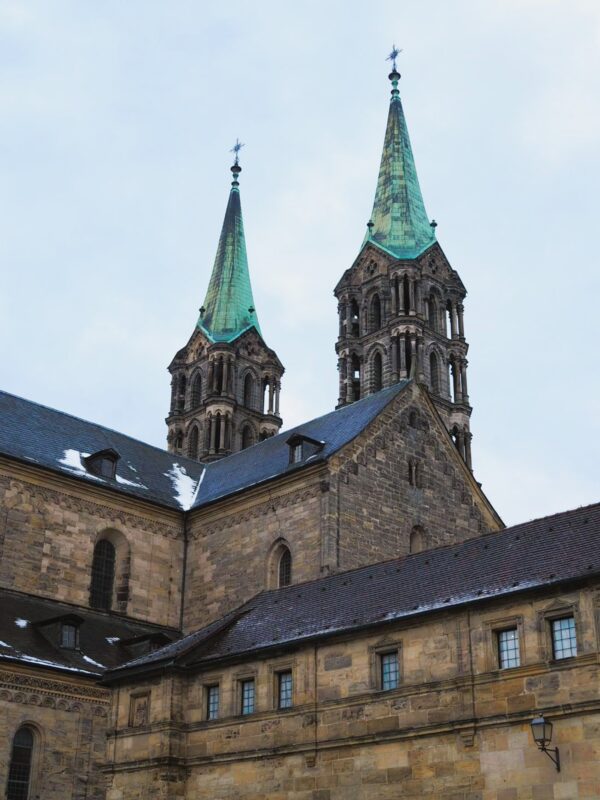
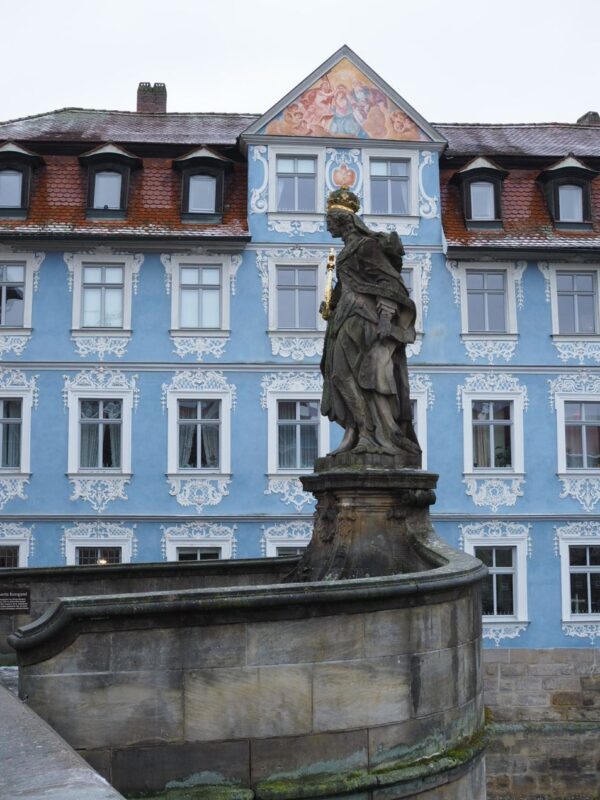
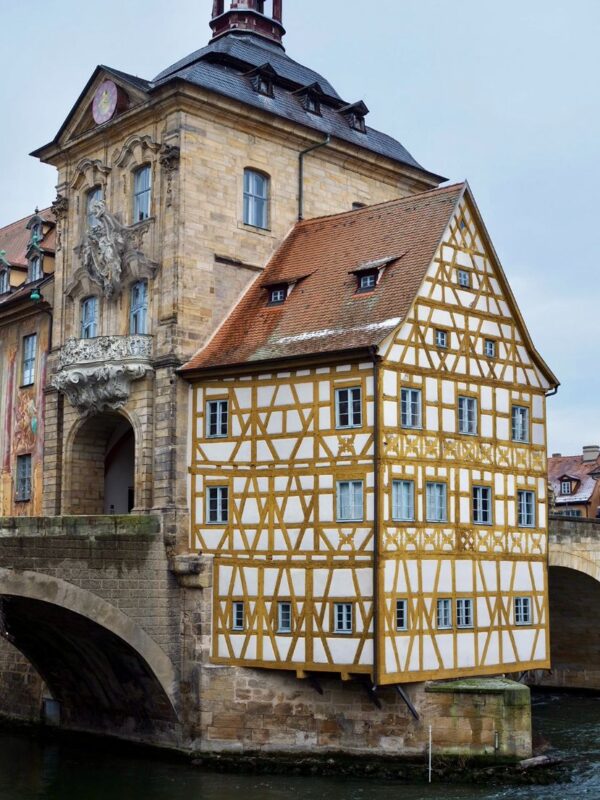
Day Trip No. 6: Augsburg
How often do the trains run: roughly every 15 minutes
How long does it take to get there: 30 min
Ticket cost per adult: Return journey booked in advance €9.90, Bayern Ticket also valid
Charming Augsburg is the 3rd largest city in Bavaria, home to a scenic medieval Old Town and the world’s oldest social housing project.
The Fuggerei was first created by the charitable endeavours of the very rich merchant Jakob Fugger.
Still running solely on his original donation back in the 15th century, it houses around 200 elderly residents in a beautiful village tucked amongst gardens and void of any cars.
Residents must be from the Catholic faith and pray three times a day, as well as attend services. In return, their rent is set at 1 Rhenish guilder per year (about 80 euro cents).
The Fuggereimuseum shows how the settlement operated before modern luxuries like electricty and running water but it is all in German. English brochures are available but with less depth of information, you might find that strolling around the village is enough for you.
You can find Herr Fugger’s OG house over at the Fuggerhaüser on Maximilianstraße, he is considered one of the richest men ever to exist with an adjusted net worth of over 500 billion dollars in today’s money.
In the beautiful medieval Old Town, you’ve got a few main attractions to go in search of.
Dom Mariä Heimsuchung dates all the way back to the 11th century, greatly extended over hundreds of years to the impressive sight that you see these days. Don’t miss the impressive stained-glass windows if you do decide to step inside.
Wander through the traces of German history at St Anna Kirche, tucked into a series of cloisters and lined with tombstones. If you’re interested in the history of the Reformation, this will be a fascinating spot to visit but it’s worth seeking out just to see the glimmering Goldschmiedekapelle and Fuggerkapelle.
Both are lavishly decorated to match their esteemed residents.
The Augsburg Rathaus, or Town Hall, is a delightfully Gothic gem topped with double onion dome spires and interestingly, a pinecone – the emblem of the city.
The Goldener Saal is an elaborate banquet hall showing off the opulence of the city, look up at the impressive ceiling covered with golden panels of frescoes.
Pop over to the Sankt Ulrich und Afra Abbey over on Ulrichplatz for one of my favourite buildings in ancient Augsburg, I just can’t get enough of the slightly whimsical architecture of the basilica and abbey.
Day Trip No. 7: Chiemsee
How often do the trains run: roughly every 15-30 minutes
How long does it take to get there: 1hr 10min
Ticket cost per adult: Bayern Ticket best value, MVV tickets possible but more expensive.
If you’re seeking a nature lover’s day trip from Munich by train, look no further than the impossibly serene Chiemsee.
Stretching for over 80 square kilometres and surrounded by pristine pine forests, locals and visitors flock to the peaceful shores of the lake for aquatic leisure time, whether that’s sailing around or swimming.
Often referred to as the Bavaria Sea since it is the largest lake in Bavaria, it’s also one of the cleanest swimming lakes.
Alternatively, if you’d like to stay dry, you can rent or bring bikes to cycle the 64km circumference of the lake and admire it from all angles, with multiple paths to choose from.
The main attractions out here – if you’re not a sailor – are on the three islands out in the lake. King Ludwig II, known for his construction of the fairytale Neuschwanstein Castle, built another palace here on the Herreninsel island.
The building of Herrenchiemsee Palace began in 1878, following the completion of the Rococo Linderhof Palace in Southwest Bavaria.
The new palace was carefully modelled on Versailles and designed to the very limits of opulence and the Bavarian royal funds, it was never finished due to Ludwig’s untimely death in 1886 but it is open to visitors daily.
Lavish decorations fill the interior and guided tours run for about 40 minutes, walking you around the impressive rooms. Don’t miss the fountains outside, they run on a fifteen minute timer so be sure to stay long enough to see the show!
Over on Fraueninsel, another island on the lake, you’ll find the pilgrimage site Abtei Frauenwörth, one of the oldest convents in Germany.
Usually, the grounds are open to stroll around and there is even a small shop where you can indulge in home-made marzipan and other souvenirs. Visit close to Christmas and you might even be able to enjoy the quaint Christmas market.
The island is completely car free and there are plenty of delightful cafes and restaurants to explore once you’ve made your way around the convent.
Head to Prien am Chiemsee to take advantage of the ferry service, buy a day ticket for the best value (18,60 € per adult) or double check the ferry website for pricing if you’d prefer to journey on your boat tour just to the palace and back.
You’ve reached the end of my guide to the 7 best day trips from Munich by train!
I hope you’ve enjoyed this guide to the best day trips from Munich by train for 2024.
We’ve roamed from the charming cottages of Bamberg up in Franconia to the fairytale castle of Neuschwanstein and hopefully you’ll enjoy some beautiful scenery on the way to your new favourite destination.
Or at least have time to go through and find your favourite photos from your wonderful day trip on the train ride.
Maybe you’ll choose to go soak up the serenity of nature over at Chiemsee or go Christmas ornament shopping in Nuremberg for the best dressed Christmas tree yet.
Maybe you even have enough time to Munich to pick a few of these top Bavarian spots to visit, I’d love to hear about where you’d like to visit first, or if you’ve enjoyed any of these cities before!
Don’t forget to share this article with your friends and pin it for later so you can find it easily before your Bavarian travels!
Got more time to spend in Germany? How about a few days in Berlin?


